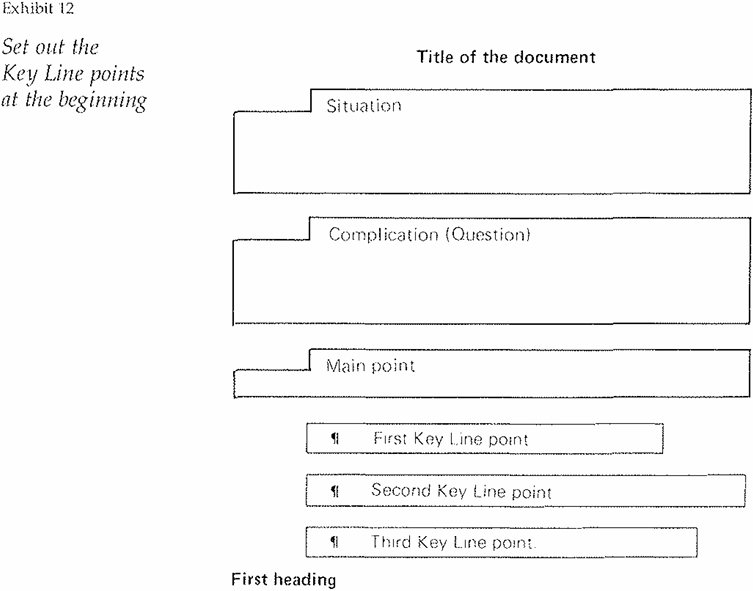
What About the Key line?
 المؤلف:
BARBARA MINTO
المؤلف:
BARBARA MINTO
 المصدر:
THE MINTO PYRAMID PRINCIPLE
المصدر:
THE MINTO PYRAMID PRINCIPLE
 الجزء والصفحة:
41-3
الجزء والصفحة:
41-3
 2024-09-07
2024-09-07
 1017
1017
What About the Key line?
The Key Line not only gives the answer to the new Question raised by the statement of your Main Point, it also indicates the plan of the document. If it is a lengthy document, therefore, you will want to set the points out in the middle of the page. You can then put a heading to represent the first point, and start writing (see, Reflecting the Pyramid on the Page).

Setting the points out enables the reader to get your entire thinking in the first 30 seconds or so of reading. Since anything that follows will serve only to explain or defend these points, you have courteously put the reader in the position of being able to determine whether he needs to go on or is ready to accept your conclusions as they stand. In any case, he now knows what to expect and can read with a greater sense of ease that there will be no unpleasant surprises.
If the document is a short one, with only a paragraph or two to support each section, you do not of course want to set out the points and then repeat them in headings. In such cases, use the points as topic sentences to your paragraphs and underline them so that they jump out at the reader.
Remember that the Key Line points should be expressed as ideas. It is not sufficient, for example, to write an introduction like the following:
This memorandum describes the project team approach to identifying and achieving significant profit improvements. It is organized in six sections as follows:
- Background
- Principles of project team approach
- What project work is
- How the program is organized
- Unique benefits and specific results
- Prerequisites for success.
Here the setout of the points is useless in the sense of conveying the message of the document to the reader. It simply forces on the reader a string of words that he can't put into perspective. It is excess baggage that wastes his time and delays his understanding.
As a rule of thumb, you never want to have a section labeled "Background" or "Introduction" because the information it contains will not be on the same level of abstraction as the other points that follow. And in listing subjects rather than ideas, there is a danger that the ideas assumed to be behind the subjects will probably not form a clear argument, either inductive or deductive.
In the example above, one suspects that the ideas in the various sections are indeed badly jumbled as they stand. For example, the "Unique benefits and specific results" should probably be discussed under the "Principles of project team approach," and the "Prerequisites for success" probably belong under "How the program is organized." Never write about categories, only about ideas.
 الاكثر قراءة في Writing
الاكثر قراءة في Writing
 اخر الاخبار
اخر الاخبار
اخبار العتبة العباسية المقدسة


